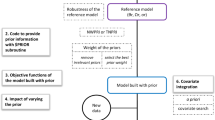Abstract
One major task in clinical pharmacology is to determine the pharmacokinetic-pharmacodynamic (PK-PD) parameters of a drug in a patient population. NONMEM is a program commonly used to build population PK-PD models, that is, models that characterize the relationship between a patient's PK-PD parameters and other patient specific covariates such as the patient's (patho)physiological condition, concomitant drug therapy, etc. This paper extends a previously described approach to efficiently find the relationships between the PK-PD parameters and covariates. In a first step, individual estimates of the PK-PD parameters are obtained as empirical Bayes estimates, based on a prior NONMEM fit using no covariates. In a second step, the individual PK-PD parameter estimates are regressed on the covariates using a generalized additive model. In a third and final step, NONMEM is used to optimize and finalize the population model. Four real-data examples are used to demonstrate the effectiveness of the approach. The examples show that the generalized additive model for the individual parameter estimates is a good initial guess for the NONMEM population model. In all four examples, the approach successfully selects the most important covariates and their functional representation. The great advantage of this approach is speed. The time required to derive a population model is markedly reduced because the number of necessary NONMEM runs is reduced. Furthermore, the approach provides a nice graphical representation of the relationships between the PK-PD parameters and covariates.
Similar content being viewed by others
References
S. L. Beal and L. B. Sheiner. Estimating population kinetics.CRC Crit. Rev. Biomed. Eng. 8:195–222 (1982).
P. O. Maitre, M. Bührer, D. Thomson, and D. R. Stanski. A three-step approach combining Bayesian regression and NONMEM population analysis: Application to midazolam.J. Pharmacokin. Biopharm. 19:377–384 (1991).
L. B. Sheiner, S. Beal, B. Rosenberg, and V. V. Marathe. Forecasting individual pharmacokinetics.Clin. Pharmacol. Ther. 26:294–305 (1979).
L. B. Sheiner and S. Beal. Bayesian individualization of pharmacokinetics: simple implementation and comparison with non-Bayesian methods.J. Pharm. Sci. 71:1344–1348 (1982).
T. J. Hastie and R. J. Tibshirani.Generalized Additive Models, Chapman and Hall, New York, 1990.
R. E. Bellman.Adaptive Control Processes, Princeton University Press, Princeton, NJ, 1961.
T. J. Hastie. Generalized additive models. In J. M. Chamber and T. J. Hastie (eds.),Statistical Models, Wadsworth and Brooks, Pacific Grove, CA, 1991, pp. 249–304.
H. Akaike. A new look at the statistical model identification.IEEE Trans. Automat. Contr. 19:716–723 (1974).
L. Breiman. The PI method for estimating multivariate functions from noisy data.Technometrics 33:125–160 (1991).
J. H. Friedman. Multivariate adaptive regression splines.Ann. Statist. 19:1–141 (1991).
C. A. DeBoor.A Practical Guide to Splines, Springer-Verlag, New York, 1978.
Author information
Authors and Affiliations
Additional information
This work was supported in part by U.S. Department of Health and Human Services grants GM 26676 and GM 26691. Jaap W. Mandema was supported by a NATO Science Fellowship awarded by the Netherlands Organization for Scientific Research.
Rights and permissions
About this article
Cite this article
Mandema, J.W., Verotta, D. & Sheiner, L.B. Building population pharmacokineticpharmacodynamic models. I. Models for covariate effects. Journal of Pharmacokinetics and Biopharmaceutics 20, 511–528 (1992). https://doi.org/10.1007/BF01061469
Received:
Revised:
Published:
Issue Date:
DOI: https://doi.org/10.1007/BF01061469




